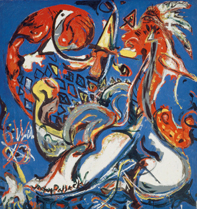Jackson Pollock
1912, Cody, Wyoming, USA – 1956, East Hampton,
New York, USA
The Moon-Woman Cuts the Circle 1943
Oil on canvas
109.5 x 104cm
Gift of Frank K Lloyd 1980
Collection: Musée national d'art modern, Centre Pompidou, Paris
AM 1980-66
© Pollock/Krasner Foundation/ARS.
Licensed by Viscopy, Sydney, 2011
The Moon–Woman Cuts the Circle was one of 14 paintings by Jackson Pollock presented at the artist’s first solo exhibition at Peggy Guggenheim’s Art of This Century gallery in New York, in November 1943. The work draws on Jungian analysis that Pollock had been undergoing since the late 1930s in an effort to combat alcoholism. A number of the drawings he was encouraged to make during the course of his treatment contained totemic and ritual imagery – some drawn from Native American cultures – which were developed further in a number of paintings for this solo exhibition.
Pollock’s interest in personal mythology and automatic expression briefly aligned his practice with that of the surrealists in the mid to late 1940s. His primary interest was in the exploration of the chance effects of gestural abstraction. The dynamic treatment of paint in The Moon–Woman Cuts the Circle indicates his awareness of surrealist automatism and the work of Roberto Matta and André Masson, both of whom he met during their exile in the United States in the 1940s.
Please note: The videos featured in this virtual tour are available to Australian audiences only.
1939–1946 SURREALISM IN EXILE
In the 1930s, Surrealism gained a foothold in North America, which was strengthened during World War Two, when many surrealists fled there in exile. Germany's occupation of France in 1940 caused the dispersal – some fled Europe altogether, while others remained to fight with the French Resistance. German artists Max Ernst and Hans Bellmer, who had moved to Paris during the early 1920s, were placed in a French internment camp. Many who sought exile abroad, including Marcel Duchamp, Victor Brauner and André Masson, found themselves alongside André Breton in the French seaport of Marseille, waiting months for travel papers allowing them passage abroad.
Finally en route to the United States in 1941, Breton and Masson spent a long sojourn in the French Caribbean. During his stay on San Domingue (now Haiti), Breton witnessed voodoo rituals that informed his ideas around art, magic and myth. In 1942, he published his Prolegomena to a Third Surrealist Manifesto, or Not, in which he outlined the theory of the ‘Great Transparencies’, mythical beings who occupied a kind of parallel reality invoked by art. Breton’s thoughts increasingly ran to magic and myth in the art of ‘primitive’, insane or ‘naive’ artists.
During this period, the international reach of Surrealism was demonstrated through numerous exhibitions in Latin and North America, with a particular focus on New York, where many artists now lived. Retrospective exhibitions of work by Joan Miró and Salvador Dalí were held at the Museum of Modern Art, New York, in 1941. ‘Artists in Exile’ was held at the Pierre Matisse Gallery, in 1942, and ‘First Papers of Surrealism’ was organised by Breton and Marcel Duchamp, in 1942. Peggy Guggenheim’s influential gallery Art of This Century opened in 1942, with one space dedicated as the Surrealist Gallery.

